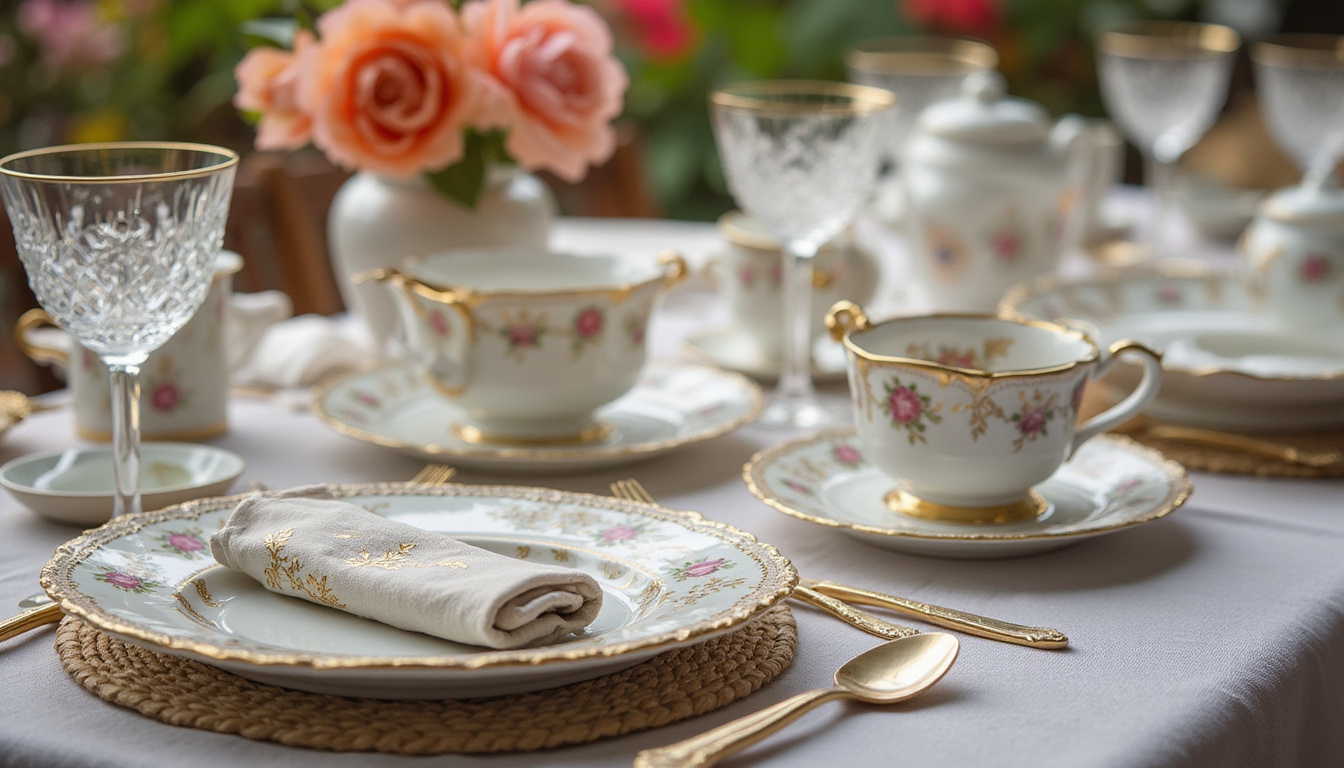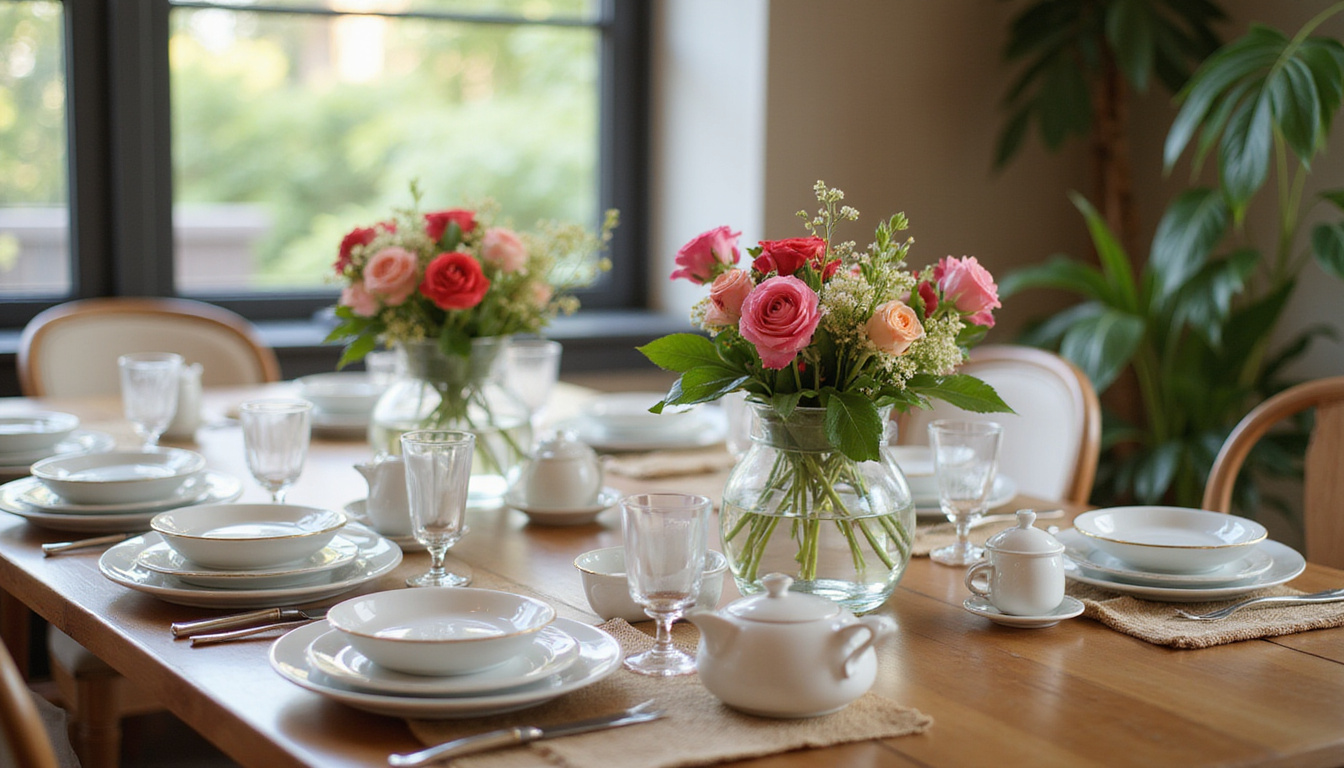
Discover the Timeless Elegance of Fine China: A Guide to Choosing, Caring, and Collecting
Fine china, renowned for its delicate beauty and timeless appeal, has a rich history that transcends centuries. Have you ever found yourself captivated by a beautifully set table adorned with exquisite china pieces? The charm of fine china is not just in its aesthetics but also in the stories and traditions it embodies. In this guide, we’ll delve into the world of fine china, exploring its history, the essential factors to consider when selecting pieces for your collection, the various types available, and how best to care for and preserve these treasures. Whether you’re an aspiring collector or simply wish to enhance your dining experience, understanding fine china can illuminate its significance in home decor and entertaining. Let’s embark on this journey to discover the elegance and artistry of fine china!

TLDR (Key Takeaways)
- Fine china is not only beautiful but also has a rich history and cultural significance.
- Choosing fine china involves considering quality, design, and usage for optimal enjoyment.
- There are various types of fine china, each with unique characteristics and purposes.
- Proper care and maintenance are essential to preserve the elegance and durability of fine china.
- Building a fine china collection requires knowledge, patience, and an eye for craftsmanship and trends.
What is Fine China? Understanding Its History and Significance
Fine china refers to high-quality porcelain characterized by its delicate appearance and durability, making it a staple in housewares and decorative arts. The creation of fine china dates back to the Tang Dynasty in China, around 618 to 907 AD, where it was first made from kaolin clay and feldspar, resulting in a product that could be fired at higher temperatures. This innovation led to the creation of thin, translucent dinnerware that, besides being functional, showcased intricate designs and artistic craftsmanship. The significance of fine china extends beyond mere utility; it often carries a rich history associated with cultural traditions, family heirlooms, and celebratory occasions. Over time, fine china has evolved with various patterns and styles, reflecting trends and the tastes of different eras. Whether used during family gatherings or displayed in glass cabinets, fine china holds a special place in many South African households, symbolizing elegance and timeless beauty.
Factors to Consider When Choosing Fine China
When selecting fine china for your dining collection, there are several important factors to consider. First and foremost, think about the style of the pieces – do you prefer classic patterns with intricate designs or a more modern, minimalist aesthetic? Next, consider the durability of the fine china. Some options are more prone to chipping and scratching, while others are designed for everyday use, providing a balance of elegance and practicality. Additionally, color plays a crucial role in how your fine china complements your existing tableware and decor. Opting for versatile colors can allow for mixing and matching with other table settings for different occasions. Lastly, always take into account the size and shape of the plates and serving pieces. Larger plates may serve well for formal dining, while smaller dishes can work wonders for appetizers or desserts. By weighing these factors, you can choose fine china that not only enhances your dining experience but also reflects your personal style.
'Fine china is more than just beautiful tableware; it is a reflection of culture, tradition, and the artistry of craftsmanship.'
The Different Types of Fine China: A Comprehensive Overview
When it comes to tableware, fine china holds a special place in both aesthetics and functionality. Known for its delicate beauty and durability, fine china can elevate any dining experience. Generally classified into various types based on their composition and intended use, understanding the different kinds of fine china can help you make informed choices when selecting dinnerware for your home.
1. Bone China: This is perhaps the most well-known type of fine china, made from a mixture of bone ash, feldspar, and kaolin. Bone china is prized for its strength, translucency, and whiteness, making it a favorite for both everyday use and special occasions.
2. Porcelain: Another popular selection, porcelain is crafted from a similar clay mixture but lacks the bone ash in its formula. It is relatively robust, making it ideal for everyday use while still offering an elegant appeal for formal dining.
3. Stoneware: Although not as delicate as bone china or porcelain, stoneware can be categorized as fine china if designed with intricate patterns and glazing. Often used for rustic and casual dining, stoneware is sturdy, chip-resistant, and adds a cozy touch to any table setting.
4. Limoges: This luxurious type of fine china is made in the Limoges region of France and is known for its exquisite craftsmanship and fine detail. Limoges china pieces are often collectors' items due to their artistry and historical significance.
5. Delftware: Originating from the Netherlands, Delftware is a type of earthenware that has been hand-painted with intricate designs, typically in blue and white. While not traditional fine china, its artistic merit and charm have earned it a special spot among collectors.
By understanding the different types of fine china, you can better appreciate their unique qualities and find the perfect pieces to enhance your dining experience. Whether you’re setting a formal table or enjoying a casual meal, the right fine china can bring elegance and character to your dining room.

Caring for Your Fine China: Tips for Maintenance and Preservation
Fine china, often a cherished heirloom or a coveted addition to your dining collection, requires special care to maintain its exquisite beauty and integrity. Proper maintenance ensures your fine china remains in pristine condition, allowing you to enjoy its elegance for generations. Here are some essential tips for the maintenance and preservation of your fine china:
1. Gentle Cleaning: Always wash your fine china by hand to avoid the harshness of a dishwasher. Use warm, soapy water and a mild dish soap with a soft sponge. Avoid abrasive cleaners and scrubbers that can scratch the surface.
2. Proper Drying: After washing, carefully dry each piece with a soft, lint-free cloth to prevent water spots. Avoid leaving your china to air dry as this can sometimes leave water marks.
3. Safe Storage: Ensure that you store your fine china in a cool, dry place. Stack plates with felt or cloth separators between each piece to prevent scratching and chipping. For cups and bowls, use bubble wrap or specialized storage containers to cushion them.
4. Avoid Quick Temperature Changes: Exposure to sudden temperature changes can cause cracks or crazing. Always allow your china to come to room temperature before immersing it in hot water or placing it in a hot oven.
5. Display with Care: If you choose to display your fine china, ensure it is in a safe location away from direct sunlight and dust accumulation. Consider using a glass cabinet to protect your pieces while still showcasing their beauty.
By following these tips, you’ll preserve the charm and elegance of your fine china, allowing you to create beautiful tablescapes or simply enjoy them as a decorative element in your home.
Building a Fine China Collection: Expert Tips for Collectors
Building a fine china collection is a rewarding endeavor that can add elegance and charm to any home. When starting your collection, focus on quality over quantity. Seek out reputable manufacturers known for their craftsmanship and history. Consider incorporating various patterns and styles to create a diverse yet cohesive collection. Pay attention to the condition of each piece; ensure they are free from chips and cracks for longevity. You might also want to explore local estate sales or antique shops, as they often have unique fine china options that you won't find in mainstream stores. Styling Tip: Display your fine china in a glass cabinet or on open shelving to showcase your prized pieces while protecting them from dust. Additionally, consider thematic collections, such as sets that celebrate South African landscapes or flora, linking personal artistry to local heritage. Remember, patience is key in this journey; over time, your collection will grow into a beautiful representation of your unique style and taste. With each new acquisition, you’re not just adding dinnerware, but creating a stunning testament to fine decoration that can be passed down through generations.
Frequently Asked Questions
What is fine china and why is it significant?
Fine china is a type of porcelain known for its durability, translucence, and white, delicate appearance. It has historical significance as a luxury item associated with wealth and fine dining, often used in formal settings and special occasions.
What factors should I consider when choosing fine china?
Consider your personal style, the type of events you will use it for, and the patterns or collections that resonate with you. Additionally, think about the quality, brand reputation, and whether the pieces are dishwasher or microwave safe.
What are the different types of fine china?
Fine china includes several categories: bone china, which is known for its strength and translucency; porcelain, characterized by its non-porous surface; and stoneware, which is more durable but typically less elegant. Each type has its own unique properties, making them suitable for various uses.
How can I properly care for my fine china?
To care for fine china, avoid exposing it to extreme temperature changes, hand wash whenever possible with mild detergent, and use soft cloths or pads while storing to prevent scratches. Regularly inspect for any signs of wear, and never place it in the microwave unless specified.
What are some tips for starting a fine china collection?
Begin by researching the brands and styles that interest you, and set a budget to avoid overspending. Attend antique shows or auctions, network with other collectors, and consider focusing on a specific theme or era to make your collection unique.
















